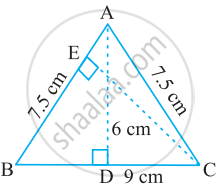Advertisements
Advertisements
प्रश्न
For what value of a point (a, 1), (1, -1) and (11, 4) are collinear?
उत्तर
Let A(a,1), B(1,-1) and (11,4) be the given point
Area of ΔABC
`=1/2{a(-1-4)+1(4-1)+11(1+1)} `
`=1/2 {-5+3+22}`
`1/2{-5a+25}`
for the point to be collinear
Area of ΔABC=20
`1/2{-5a+25}=0`
`=>-5a+25=0`
`=>-5a=-25`
`=>a=5`
APPEARS IN
संबंधित प्रश्न
If A(−4, 8), B(−3, −4), C(0, −5) and D(5, 6) are the vertices of a quadrilateral ABCD, find its area.
Find the area of the quadrilateral ABCD whose vertices are respectively A(1, 1), B(7, –3), C(12, 2) and D(7, 21).
Prove that the points (2, – 2), (–3, 8) and (–1, 4) are collinear
The two opposite vertices of a square are (− 1, 2) and (3, 2). Find the coordinates of the other two vertices.
ΔABC is isosceles with AB = AC = 7.5 cm and BC = 9 cm (see the given figure). The height AD from A to BC, is 6 cm. Find the area of ΔABC. What will be the height from C to AB i.e., CE?

The vertices of ΔABC are (−2, 1), (5, 4) and (2, −3) respectively. Find the area of the triangle and the length of the altitude through A.
If A(5,2), B(2, -2) and C(-2, t) are the vertices of a right triangle with ∠B=90° , then find the value of t .
Find the value of y for which the points A(-3, 9), B(2,y) and C(4,-5) are collinear.
In ∆PQR, PR = 8 cm, QR = 4 cm and PL = 5 cm. 
Find:
(i) the area of the ∆PQR
(ii) QM.
A(6, 1), B(8, 2) and C(9, 4) are three vertices of a parallelogram ABCD. If E is the midpoint of DC, find the area of ∆ADE.
